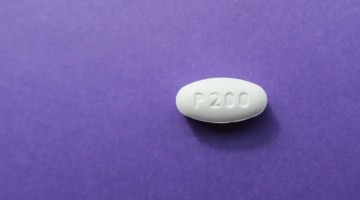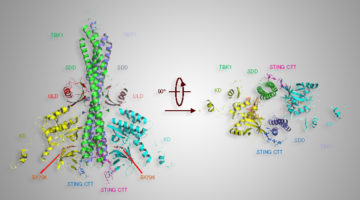A collaboration of university and industry researchers used x-ray crystallography to investigate how the chikungunya virus, which can cause debilitating joint pain, engages a receptor protein found on the surfaces of joint cells. The work provides a path forward in the fight against a family of viruses that can result in acute and chronic arthritis. Read more »![]()
![]()
ALS Work Using Protein Crystallography
Protein crystallography is used for determining the molecular structure of proteins. Crystallized protein molecules cause a beam of incident x-rays to scatter in many directions, with constructive and destructive interference generating a diffraction pattern. By analyzing these patterns, a crystallographer can produce a three-dimensional picture of the density of electrons within the crystal and thus determine the protein's structure.
Unique Cancer Drug Discovered With Help From Advanced Light Source Begins Historic Clinical Trial
Errors in the KRAS gene, which encodes a crucial cell-signaling protein, are one of the most common causes of cancer. Seeking to develop a long-sought direct inhibitor, researchers at Amgen conducted x-ray crystallography of KRAS(G12C) proteins at the ALS. The high-resolution structural maps helped Amgen make the breakthrough discovery of a small pocket on the molecule. Read more »
Structural Basis for Finding OG Lesions and Avoiding Undamaged G by the DNA Glycosylase MutY
Finding OG and avoiding G: DNA repair enzyme MutY distinguishes between undamaged guanine (green) and oxidized guanine when targeting OG:A mispairs. A structural motif within the C-terminal domain (violet) responds to OG to G substitution and appears mechanistically coupled to the adenine removal site (gray) in the N-terminal domain (cyan). Read more »
Discovery of a Covalent Inhibitor of KRASG12C (AMG 510) for the Treatment of Solid Tumors
KRASG12C has emerged as a promising target in the treatment of solid tumors; however, clinically viable inhibitors have yet to be identified. Here, researchers report on structure-based design and optimization efforts, culminating in the identification of AMG 510, a highly potent, selective, and well-tolerated KRASG12C inhibitor currently in phase I clinical trials (NCT03600883). Read more »
Genetic Blueprint for the Bioproduction of an Antidepressant Drug Candidate
A set of genes from a marine bacterium has been found to encode the biosynthesis of a promising antidepressant drug candidate. This work, which used the ALS to solve the structure of a key enzyme, could enable industrial-scale bioproduction of the drug in ways that are more efficient and sustainable than chemical synthesis. Read more »
A Citizen-Science Computer Game for Protein Design
Using the computer game, “Foldit,” nonexpert citizen scientists designed new proteins whose structures, verified at the ALS, were equivalent in quality to and more structurally diverse than computer-generated designs. The work shows the potential of using crowd-based creativity in the design of new proteins for fighting illness and disease. Read more »![]()
![]()
X-Ray Experiments Contribute to Studies of a Drug Now Approved to Combat Tuberculosis
The U.S. Food and Drug Administration has approved a new antibiotic that, in combination with two existing antibiotics, can tackle one of the most formidable and deadly treatment-resistant forms of the bacterium that causes tuberculosis. Studies exploring the structure and function of the new drug benefited from x-ray experiments at the ALS. Read more »
A Bullfrog’s Powerful Defense Against Toxic Red Tides
Working as a “molecular sponge,” a bullfrog protein known as saxiphilin provides powerful, yet little understood, protection against deadly neurotoxins produced in red tides. Crystallography studies at the ALS have clarified saxiphilin’s function, potentially enabling better ways to monitor and combat toxins in our oceans and food supplies. Read more »![]()
X-Ray Studies Key in Study Relating to Immune System-Signaling Protein
A grouping of amino acids—part of an important signaling protein, STING—plays an important role in activating the immune system. A study conducted through the Collaborative Crystallography program at the ALS confirmed how this part of the STING protein helps to bind a protein-modifying enzyme associated with autoimmune diseases and some cancers. Read more »
A Frog Worth Kissing: Natural Defense Against Red Tide Toxin Found in Bullfrogs
Researchers have discovered how a protein produced by bullfrogs binds to and inhibits the action of saxitoxin, a deadly neurotoxin that causes paralytic shellfish poisoning. The findings could lead to the first-ever antidote for the compound, which blocks nerve signaling in animal muscles, causing death by asphyxiation when consumed in sufficient quantities. Read more »
- « Previous Page
- 1
- …
- 6
- 7
- 8
- 9
- 10
- …
- 15
- Next Page »









